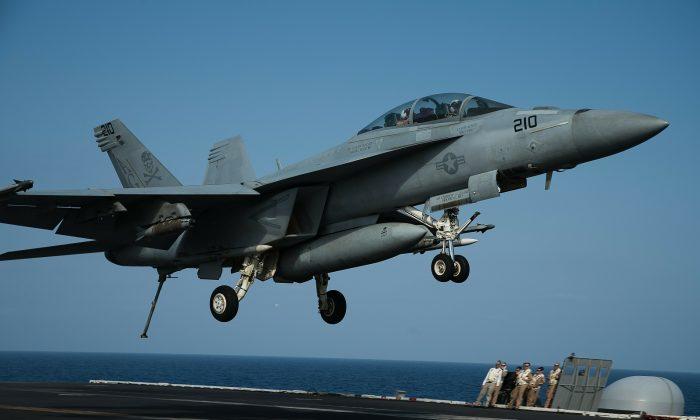ABOARD THE USS ABRAHAM LINCOLN—The U.S. aircraft carrier ordered by the White House to rapidly deploy to the Mideast over a perceived threat from Iran remains outside the Persian Gulf, so far avoiding any confrontation with Iranian Revolutionary Guard forces, amid efforts to de-escalate tensions between Tehran and Washington.
Officers aboard the USS Abraham Lincoln repeatedly told The Associated Press on June 3 they could rapidly respond to any regional threat from their position, at the time some 200 miles off the eastern coast of Oman in the Arabian Sea.
However, after decades of U.S. aircraft carriers sailing through the Strait of Hormuz, the narrow mouth of the Persian Gulf through which a third of all oil traded at sea passes, the U.S. Navy’s decision to hold the Lincoln away is striking.
“You don’t want to inadvertently escalate something,” Capt. Putnam Browne, the commanding officer of the Lincoln, told the AP.
The White House in May deployed the Lincoln and B-52 bombers to the Persian Gulf. The United States also plans to send 900 additional troops to the Mideast and extend the stay of another 600, as tens of thousands of others also are on the ground across the region.
The crisis takes root in President Donald Trump’s withdrawal last year of the U.S. from the 2015 nuclear deal between Tehran and world powers, which capped Iran’s uranium enrichment activities in return for lifting sanctions. Washington subsequently re-imposed sanctions on Iran, sending its economy into freefall.
Trump has argued that the deal had failed to sufficiently curb Iran’s ability to develop nuclear weapons and ballistic missiles, or halt its support for militias in the Mideast.
The United States has made a point to show its arsenal in the region. On June 2, the U.S. Air Force announced a B-52 conducted a training exercise with the Lincoln that included “simulated strike operations.”
That came as June 3 marked the 30th anniversary of the death of Ayatollah Ruhollah Khomeini, the founder of Iran’s Islamic Republic. Thousands in Iran commemorate Khomeini’s death by visiting his golden shrine south of Tehran. This year, Iranian military officials reportedly plan to guard it with HAWK surface-to-air missiles, the same kind the United States delivered to the Islamic Republic during the Iran-Contra scandal.
However, in recent days, the Trump administration has stressed it is ready to speak to the Iranians without preconditions. Iran, in turn, has demanded the United States show it respect.
Though officials repeatedly declined to discuss it, keeping the Lincoln out of the Strait of Hormuz and Persian Gulf helps to de-escalate the situation. Transits through the strait, which at its narrowest point is just 21 miles wide, often see the paramilitary Revolutionary Guard naval forces shadow U.S. warships. They’ve also run snap missile launches, fired machine guns and flown drones over U.S. carriers.
Asked about why the Lincoln hadn’t gone through the strait, Rear Adm. John F.G. Wade, the commander of the carrier’s strike group, said that his forces could “conduct my mission wherever and whenever needed.” While he declined to discuss any specifics about that mission, he said Iran had presented “credible threats” to the region.






Friends Read Free